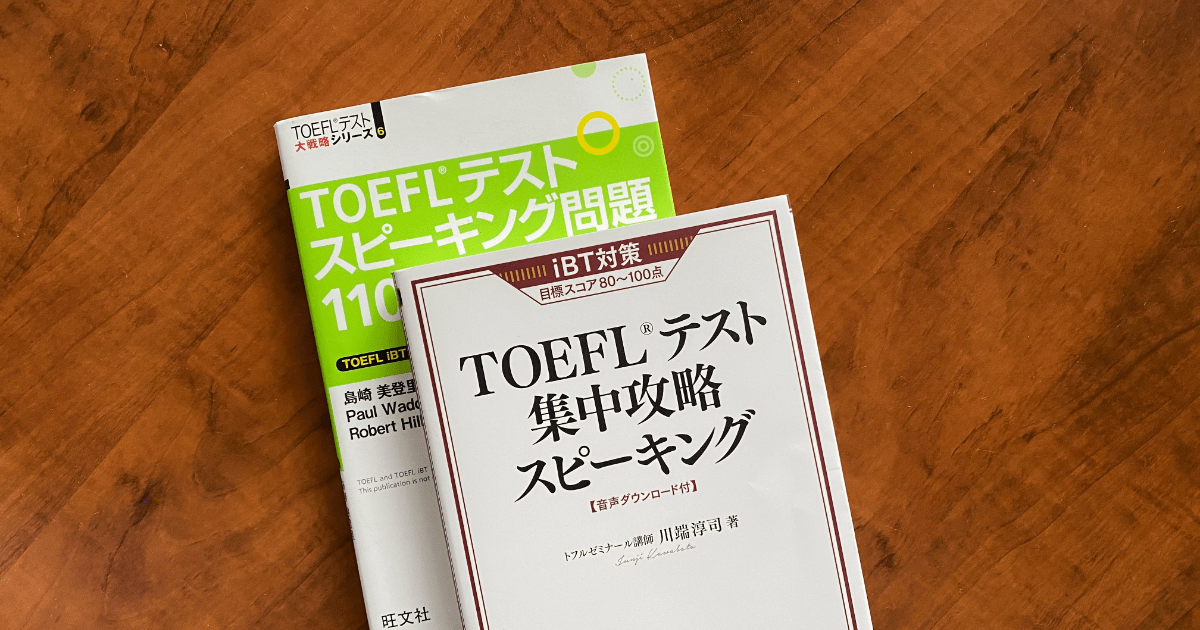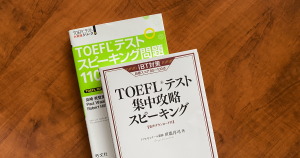TOEFLスピーキングは高得点が取れる答え方があります。テンプレートをしっかり学んで、スコアアップにつなげましょう。
TOEFL スピーキングの概要とテンプレート
TOEFL スピーキングセクションの概要を確認しておきましょう。
TOEFLのスピーキング問題は、4つの質問で構成されており、試験時間は約16分です。
各質問に対して、準備時間と解答時間がそれぞれ決められています。
Q1はIndependent taskと言い、質問に対し答える問題。
Q2-4はIntegrated taskと言い、リーディングやリスニングとの統合問題です。
ただ自分の考えを喋ればいいわけではなく、リーディング・リスニングの内容を踏まえた解答をしなくてはいけません。
スピーキングのテンプレートを覚えて「話す!」ことが肝心です。
TOEFLはコンピューターで受験する試験ですが、スピーキングの場合でもコンピューターに向かって話すことになります。
| 問題形式 | 準備時間 | 解答時間 | 概要 | |
|---|---|---|---|---|
| Q1 | Independent task | 15秒 | 45秒 | 一般的な話題 |
| Q2 | Integrated task (Reading+Listening) | 30秒 | 60秒 | キャンパス生活に関する話題 |
| Q3 | Integrated task (Reading+Listening) | 30秒 | 60秒 | 講義の一部 |
| Q4 | Integrated task (Listening) | 20秒 | 60秒 | 講義の一部 |
TOEFL スピーキングの採点基準
TOEFLのスピーキングは全4問のコンピューターに向かってスピーチをする形式です。
AIと人間の採点です。4、3、2、1、0のいずれかの評価点を評価基準をもとに計算されます。
4つの採点項目は
- General Description (タスクの完成度、理解度)
- Delivery(流れ、発音、ペース、イントネーション等)
- Language use(文法と用語の使い方)
- Topic development(内容と論理性)
採点官の5段階評価はこちら
0点: 全く話していない
1点: ほとんど話していない、話が発展しておらず、文法と語彙がかなり限定的
2点: 話の展開が限定的で途切れがち。基礎文法の使用
3点: 具体性に欠ける、文法・語彙が限定的であり、発音などに若干問題がある
4点: 構成が明確、文法・語彙が適切に使え、スムーズに話せる
これらの素点と言われる点数が1-30満点の点数に換算されます。
| Rubric mean (素点) | Scaled score(1-30点) |
|---|---|
| 4.00 | 30 |
| 3.83 | 29 |
| 3.66 | 28 |
| 3.5 | 27 |
| 3.33 | 26 |
| 3.16 | 24 |
| 3.00 | 23 |
| 2.83 | 22 |
| 2.66 | 20 |
| 2.50 | 19 |
| 2.33 | 18 |
| 2.16 | 17 |
| 2.00 | 15 |
| 1.83 | 14 |
| 1.66 | 13 |
| 1.50 | 11 |
| 1.33 | 10 |
| 1.16 | 9 |
| 1.00 | 8 |
Advanced (25–30) 上級ユーザー
High-Intermediate (20–24) 有能なユーザー
Low-Intermediate (16–19) 中程度のユーザー
Basic (10–15) 限定的なユーザー
Below Basic (0–9) 非ユーザー
TOEFL スピーキング 問題形式別対策
タスク1 Independent task (独立問題)
TOEFL スピーキングのタスク1では、一般的なトピック(familiar topics)について質問されます。
familiar topicsは、具体的には、person (人), object (物), place (場所), event & activity (行事と活動)などを指します。
解答の準備時間は15秒、実際に解答する(話す)時間は45秒です。
Which do you prefer? Agree or disagree?
と問われるので、自分がどちらを好きか、どちらに賛成/反対するかという立場を述べて、その理由について、具体例を入れて話します。
【ポイント】
- 必ず、自分の意見、理由を2つ(以上)と、それぞれの理由に関する具体例を述べましょう!
| TOEFL スピーキング タスク1のテンプレート |
|---|
| Introduction (イントロ): Personally, I believe that A. |
| Argument 1 (1つ目の理由) |
| Argument 2 (2つ目の理由) |
| Conclusion (結論): That is why I believe that A. |
【問題例】
Do you prefer to go out to dinner or stay home and cook a meal?
TOEFL Speaking Part 1 例題
Use reasons to support your response.
【解答例】
- Personally, I love cooking in my own home. There are so many reasons for this.
- First, financially, it’s impossible to eat out often. You would end up spending a lot of extra money for no reason.
- Second, health-wise, when I cook at home, I have control and can produce much more nutritious meals. Outside, I have no idea of the quality or quantity of the ingredients they have used.
- Third, emotionally, cooking at home makes me feel relaxed, happy and secure. It gives me a warm feeling to know that my home smells of the delicious food that I have cooked. I also enjoy sharing a meal with my loved ones.
- That’s why I only eat out on very special occasions or when I have no choice.
タスク2 Integrated task (統合問題)
TOEFL スピーキングのタスク2では、キャンパス生活に関連したトピックについて、リーディングとリスニングを踏まえた上で質問に答える問題が出題されます。
お知らせの内容に対して、どちらか一方の学生の意見をまとめた上で、なぜその学生がそう考えるのか説明するタスクです。
【ポイント】
- リスニングの時に、リーディングの画面は消えてしまうため、リーディングの内容(what/where/when)を簡潔にメモしておきましょう。
- リスニングの内容は、男性の発言・女性の発言に分けて、なるべく詳しくメモを取りましょう。
- スピーキング準備時間の30秒のうちに、メモを書き足して、順序良く読めるようにしておきましょう。
- レポート形式の場合は、必ず動詞の時制は現在形で話します。
〇 the man says that ~
✕ the man said that ~ - スピーキングの時は、メモした内容を順序良く話していきます。
| TOEFL スピーキング タスク2 テンプレート |
|---|
| There is an announcement on campus about ~ |
| Two students discuss the announcement ~ |
| The man says ~ |
| The woman says ~ |
それでは、例題を確認していきましょう。
タスク2は、以下の流れで進みます。
リーディング(45秒)
↓
リスニング
↓
設問に対するスピーキング(準備時間30秒、解答時間60秒)
【問題例】
| リーディングパート(45秒) |
|---|
| The health center is planning to make changes in the health fees. Read the notice from the health centre. Begin reading now. A Notice from the Health centre The Health centre will be offering flu vaccinations for $15 at the start of next month. There is a limited supply so be sure to sign up for an appointment as soon as possible. Last flue season vaccinations were free, but due to a reduction in student fees, there will be a charge for certain medical services that formerly were free. Also, there has been an increase in the cost of the medicines form the pharmaceutical company. As a result, there will be an additional $5 charge on all prescription medicine dispensed by the Health centre. |
| リスニングパート |
|---|
| Now listening to two students discussing the notice. M: That’s pretty good deal. W: What do you mean? They increased the price of the vaccine and now we have to pay additional fees for some health services. M: It’s still cheaper than if you went to the hospital to have it done. I hear that they charge $80 per vaccine. We are saving a tone of money just by using the Health centre. Also, prescription medicines is still less that half the price of what the pharmacy downtown is charging you. W: I guess you are right. IT just doesn’t seem fair that we have to pay a semester health fee and now we are going to have to pay even more. M: Either way, you look at it we are still benefiting from it. You don’t have to go get a flue shot if you don’t want one, and we aren’t going to have to pay an increased health fee next semester. The only time it costs you more is if you get sick, and that seems pretty fair to me. W: Yeah, maybe to you but I always end up getting sick this time of the year. M: Well, then I suggest that you start wearing some warmer clothing and try using an umbrella. |
The man expresses his opinion of the notice from the Health centre.
TOEFL Speaking Part 2 例題 スピーキング
State his opinion and explain the reasons he gives for holding that opinion.
【解答例】
The notice was about increase of health fees. The man says that he feels the increase of health fees is still a good deal although she kind of disagrees. He points out that the cost of an influenza shot is $65 or more at a hospital. He also says that prescription medicine at the health centre is half the price of what it is at the downtown pharmacy. He also reminds her that they are not going to have to pay for an increased health fee and only have to spend the money on the hot if they want, or pay for medicine only when they get sick. He suggested that she be better prepared for weather conditions by dressing warmly and bringing umbrella not to get sick.
タスク2の回答に便利な表現
- According to the passage/announcement/flyer, the university plans to …
- The school intends to …
- The passage/announcement/flyer explains that the university is considering …
- The student agrees/disagrees with the school’s changes/decision/proposal for two/three reasons.
- The student supports/opposes these changes.
- However, the student does not support this plan.
- First, the student believes/feels/thinks that …
- The first point the student makes is that …
- One reason is that …
- One reason he/she supports/opposes this proposal is that …
- According to the student, …
タスク3 Integrated task (統合問題)
TOEFL スピーキングのタスク3では、アカデミックなトピックについて、リーディングとリスニングを踏まえた上で質問に答える問題が出題されます。
リーディングでは、テキストブックの抜粋が、リスニングでは、講義の一部が出題されます。
ある学問の分野における概念や、その概念の具体的な例との関連性を説明する問題です。
【ポイント】
タスク2とほぼ同じです。
- リーディングの内容(what/where/when)を簡潔にメモしておきましょう。
- リスニングの内容は、なるべく詳しくメモを取りましょう。
- スピーキング準備時間の30秒のうちに、メモを書き足して、順序良く読めるようにしておきましょう。
- レポート形式の場合は、必ず動詞の時制は現在形で話します。
〇 the speaker says that ~
✕ the speaker said that ~ - スピーキングの時は、メモした内容を順序良く話していきます。
| TOEFL スピーキング タスク3の テンプレート |
|---|
| The reading passage discusses ~ |
| The lecturer says ~ |
それでは、例題を確認していきましょう。
タスク3も、タスク2と同様以下の流れで進みます。
リーディング(45秒)
↓
リスニング
↓
設問に対するスピーキング(準備時間30秒、解答時間60秒)
【問題例】
| リーディングパート(45秒) |
|---|
| Now read the passage about gentrification. Start reading it now. Ascribed status and Achieved status All human beings, as individuals, belong to a variety of social groups, and within those groups we all have a status and a role to fulfill. Our status is defined as our relative social position within a group. Statuses can vary from culture to culture, but in all societies, statuses are either achieved or ascribed. Achieved statuses are acquired by doing something. A firefighter can become a hero by saving lives, or a person can become a criminal by committing a crime. Ascribed statuses, on the other hand, are the result of being born in to a particular family or being born, for example, a male or a female. They are not the result of a decision or choice made by the individual. |
| リスニングパート |
|---|
| Now listen to part of he lectures in a sociology class. So, class, today let’s consider the concept of status. When we hear expressions like status symbol, we tend to think of status as a higher social position. Remember, however, that social status in this case usually refers to only one kind of status, that is, economic status. In sociology, we are interested in all kinds of statuses. Everyone in this class has both an achieved status and an ascribed status. Your achieved status is that of college student – you took certain actions and met certain requirements which earned you this status. Your gender, however, was not your choice. You were achieved statuses, and rejects the notion that ascribed statuses should give one member of society an advantage over any other member of society. |
Explain the difference between achieved status and ascribed status, using the samples give in the professor’s talk.
TOEFL Speaking Part 3 例題 スピーキング
【解答例】
Both the passage and the lecture discuss the definitions of ascribed status and achieved status. The professor states that the difference between achieved status and ascribed status is that achieved status can be chosen, but ascribed status cannot. He says that an achieved status is something that is earned, for example, w person who meets certain requirements and makes certain decisions earns the status of being a college student. Ascribed status is something that people are sometimes born into. The professor gives the example of gender as an ascribed status. A person can’t choose to be born as a male or female. Generally speaking, American society tends to put more emphasis on achieved statuses that ascribed statuses and discourages discrimination on the basis on ascribed statuses.
タスク3の回答に便利な表現
- The passage discusses _____ and how it
- The main focus of the passage is …
- Both the passage and the lecture discuss …
- According to the lecture, _____ is …
- The passage introduces the concept of …
- In the lecture, the professor defines _____ as …
- The professor elaborates on this concept/term, explaining that …
- The professor first mentions that …
- First off, the professor talks about …
- Next, the professor discusses …
- The professor also explains that …
- Additionally, the professor says that …
- Another example the professor gives is that …
- This is what _____ means.
- And this is the meaning of …
- So this is how the professor describes …
タスク4 Integrated task (統合問題)
TOEFL スピーキングのタスク4では、アカデミックなトピックについて、リスニングを聞いて質問に答える問題が出題されます。
リスニングでは、講義の一部が流れるので、講義の内容を要約する問題です。
準備時間は20秒、解答時間は60秒です。
【ポイント】
- 講義の内容が高度で長いのですが、その内容をリポートする(要約する)だけなので、メモをしっかり取りましょう。
- 具体的な例や詳細が取れなくても、講義のキーポイントだけでも抑えてサマリーを述べましょう。
| TOEFL スピーキング タスク4のテンプレート |
|---|
| The lecturer discusses ~ |
【問題例】
| リスニングパート |
|---|
| So class, today, I am going to talk about radon. Every day we are exposed to the threat of radon in our own homes. The reason is that the airspace in a home is enclosed. The more we ventilate our homes, by opening windows for example, the better our chances of reducing the formation of radon gases. Radon is a natural element in our atmosphere that comes from disintegration of radium. If high concentrations of radon enter our lungs, we increase the chances of getting lung cancer. Radon enters the home through things such as loose pipes or cracks in the floor. It may also enter the house through the water but the majority of it comes from foundation. There are two ways to test for radon which are called passive and active. An example of a passive tester would be a charcoal disk that collects radon. This disk is then later treated with a chemical to find out the concentration of radon in the home. An example of an active taster would be something that uses electricity and continuously monitors the levels. It might be a device that you plug into the wall socket and, like a fire alarm, will beep when it reads a level that is too high. The best way to protect yourself from radon is to check with the U.S. Environmental Protection Agency. They have a listing of radon levels for all the areas in the U.S. and can tell you if your home is located in one of the danger areas. |
Using points and examples from the talk, explain radon presented by the professor.
TOEFL Speaking Part 4 例題 スピーキング
【解答例】
Radon is a natural element that arises from the breakdown of radium. The danger from radon comes from large concentrations of it that settle inside of our lungs. The result of this condition is that the person can contract lung cancer. A good way to protect yourself from radon exposure is to ventilate your home regularly. Another thing that can be done is to fill the cracks in your house’s floor and tighten pipes because radon enters the home form the foundation. An additional form of protection would be to have a radon indicator in the home. This could come in the form of a passive or active tester. It is also recommended that you contact the U.S. Environmental Protection Agency to find out the levels of radon in your area.
TOEFL スピーキングフルテスト モデルアンサー
当校のTOEFL スピーキングのモデルアンサーです。
スピーキングテストで非常に重要になる「メモ」のサンプルも掲載しているので、参考にしてみてください。


TOEFL スピーキングのコツ まとめ
スピーキングの試験だが、リーディング(速読)・リスニングのスキルも求められる
メモをうまく取れるように日頃から練習しておくべき
解答時間が決まっているため、時間内にまとめることを意識する



